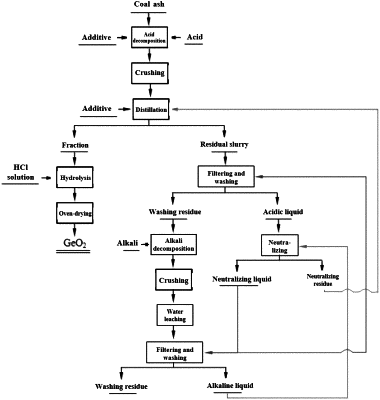| CPC C22B 41/00 (2013.01) [C22B 3/12 (2013.01)] | 11 Claims |

|
1. A method for extracting germanium based on an acid decomposition, comprising an acid decomposition step and a post-treatment step, wherein
the acid decomposition step comprises sub-steps of:
1) adding an acid to a coal ash containing germanium for a conditioning to obtain a first material; and
2) heating the first material to a temperature of 350° C. to 800° C., and keeping the first material at the temperature of 350° C. to 800° C. for 10 min to 10 h to obtain an acid-decomposed material; and
the post-treatment step comprises sub-steps of:
1) milling the acid-decomposed material until more than 60% of a first milled material has a particle size of less than 200 mesh to obtain a second material;
2) subjecting the second material to a distillation to obtain a residual slurry and a distillation fraction;
3) hydrolyzing the distillation fraction with a dilute hydrochloric acid solution, and then oven-drying to obtain GeO2;
4) filtering and washing the residual slurry to obtain a first washing residue and a residual mixed slurry, wherein the residual mixed slurry comprises a distillation residue and a residue-washing solution; and
5) adding an first alkali to the first washing residue, heating to a temperature of 350° C. to 1,000° C., and holding the temperature of 350° C. to 1,000° C. for 10 min to 10 h to allow an alkali decomposition to obtain an alkali-decomposed material; milling the alkali-decomposed material until more than 60% of a second milled material has the particle size of less than 200 mesh to obtain a third material; adding water to the third material according to a solid-to-liquid volume ratio of 1 to 20, stirring at 10° C. to 100° C. to allow a water leaching for 0.5 h to 10 h, and filtering and washing to obtain a water-leaching washed residue and a water-leaching mixed liquid, wherein the water-leaching mixed liquid comprises a water-leaching solution and a water-leaching residue-washing solution; neutralizing the water-leaching mixed liquid and the residual mixed slurry to obtain a first neutralizing residue and a first neutralizing liquid; and
returning the first neutralizing liquid to the sub-step of filtering and washing; or
adding a second alkali to the first washing residue, conducting a pressure alkali leaching, and filtering and washing to obtain a second washing residue and an alkali-leaching mixed liquid;
neutralizing the alkali-leaching mixed liquid and the residual mixed slurry to obtain a second neutralizing residue and a second neutralizing liquid; and returning the second neutralizing liquid to the sub-step of filtering and washing.
|